The remaining wines are now available for direct order!

Reading Roagna’s manifesto with my Vigneron’s cap on, it’s clear that they are driven to achieve excellence. In many ways, their approach reminds me of Yarra Yering. Pushing the boundaries with so many aspects of viticulture and winemaking, taking calculated risks, that, when successful, result in what are undoubtedly some of the best Nebbiolo wines of the world, and, occasionally some failures. Few and far betweeen now!
Not long ago we devoured a 2010 Pira, Roagna’s only Barolo amongst their stunning Barbaresco’s. The expression of the wine was breathtaking. It opened and blossomed beautifully over the course of the evening.
We’re fortunate that Roagna release their wines late. We have already seen many 2015 Barbaresco and Barolo wines. Safe in the knowledge that Roagna, like all of the greats, manages to elicit every ounce of goodness from a vintage, their 2015’s will be loads of fun!
If you’ve never tried Roagna’s wines make sure you, at minimum, grab a bottle of the Langhe. Although a blend across the Barolo and Barbaresco vineyards of Pira and Pajè respectively it will give you a great insight into the style and beauty of Roagna.
This set of new releases from Luca Roagna is full of highlights. … The 2015s are typical wines for the year. They are surprisingly open and available now, which may come as a surprise to readers weaned on the classically austere wines of the past. In exchange, though, the wines are a bit less precise in their expression of site. In other words, 2015 in a nutshell. A focus on old vineyards and non-interventionalist winemaking with extended time in oak (but not as much as in the past) drive the approach at Roagna.
Antonio Galloni, Vinous
The Roagna Estate
Roagna has long roots in the commune of Barbaresco, started in the twentieth century by Vincenzo Roagna. Vincenzo passed on the reigns to his son Giovanni Roagna, who in his turn saw his son Alfredo succeed him as the head of the estate. Today the property is run by the fifth generation of the family, Luca Roagna. Luca took on the winemaking for the property soon after his graduation from oenological school in 2001. The style of the estate’s wines has been consistently safeguarded down through all five generations of Roagna family members who have steered the property, with the wines made in a very traditional and classic style. These are deep, complex and structured wines that are built to age and handsomely reward cellaring.
The heart of the Roagna estate is its six and a half hectares of vineyards in the commune of Barbaresco, most of these lying in the fine cru of Pajè. From the Pajè vineyard the Roagna family now makes three distinct cuvées, a Barbaresco “normale” labeled as Barbaresco “Pajè,” a Barbaresco Paje Vecchie Vite (old vines) and “Crichët Pajè” – made from the crest of the Paje cru. In 1989 the family’s long-held aspirations of owning top level crus in Barolo comparable to their Pajè holdings in Barbaresco came true, when they purchased a parcel historically known as La Rocche e La Pira, in the fabled village of Castiglione Falletto. Through the 2004 vintage wines from that Vineyard were labelled as either Barolo “La Rocca e La Pira” or Barolo Riserva “La Rocca e La Pira.” For the 2005, 2007 and 2008 vintages, wines form that vineyard were labelled as “La Pira” or “La Pira Vecchie Vite” though the fruit was sourced from the same vineyard. It was changed again beginning with the release of the 2009 wines – they now have to be labelled with simply “Pira” which is the new official name of the vineyard according to the new disciplinary for the Barolo appellation. There will also sometimes be a Barolo Pira Vecchie Vite selection from the oldest vines in the cru and he will still occasionally release a Riserva selection which would be a barrel or barrels of the VV which were held back for additional time in the cellar.
Luca Roagna continues to step up his game. This is a superb set of new releases. The 2011 Barbarescos are gorgeous. They will also drink well with minimal cellaring, which, as Vinous readers know, is quite unusual for these wines. At the same time, the 2011s retain a very classic sense of mid-weight structure and good overall freshness, which gives them exceptional balance. One of the more recent developments at Roagna has been a move towards shortening the amount of time the wines spend in cask (something I am seeing at quite a few traditionally minded estates) with the goal of retaining a bit more freshness in the wines and allowing the aging to take place in bottle rather than in oak. In my view, that is a huge positive. One of the unfortunate results of the investments Roagna has made in recent years has been an increase in pricing. For that reason, I am often attracted to the Barbaresco Pajé and its sibling, the Barolo Pira. Still, it’s hard not to be impressed with the overall level of quality here. Antonio Galloni, Vinous
MANIFESTO….. THE ROAGNA WAY
After the order form you’ll find the full Manifesto. It makes for facinating reading.
#01 OLD VINES LOCATED IN HISTORIC VINEYARDS
#02 MASSALE SELECTION – NO CLONES – SINGLE VINEYARD WINES
#03 BIODIVERSITY, NO HERBICIDES, NO PESTICIDES, NO FERTILIZERS
#04 MATURITY AT HARVEST
#05 WILD YEAST FERMENTATION
#06 LONG AGING IN LARGE OAK CASKS
#07 BOTTLING USING LOW SULFUR AND NO FILTRATION OR FINING
#08 LONG MACERATION USING A SUBMERGED CAP
#09 FAMILY TRADITION
#10 PURITY FROM THE TERROIR WITHOUT ANY OAK FLAVOUR
Roagna’s Wine Making
I don’t necessarily agree that there is no change at Roagna, introducing Chardonnay and cultivating seedling from ‘Selection Massale’ (choosing the best vines in the vineyard) being two examples of change.
These notes from the importer paint an accurate picture of Roagna
I would classify Roagna as an ultra traditional producer. In fact, the wineries motto is ‘Roagna does not change’. This is a pretty powerful message to the wineries that go points chasing. To Luca Roagna, he does not care if his wines score 96 points or 69 points. It will not change the way he makes wine. It is true that Roagna is not for everyone. No problems with that. However, if you do dig the wines, each different cru will blow you away.
The vinification techniques employed in the Roagna cellars have not changed a bit with Luca Roagna taking the helm. The fermentation still includes a full sixty day maceration before aging in large, Slavonian oak botti for anywhere from three to five years (depending on the quality of the vintage) prior to bottling. The wines are bottled unfined and unfiltered, and often the estate will also hold back the wines for several years of further bottle aging prior to release. In addition to their fine Barbaresco and Barolo bottlings, the property also makes a Nebbiolo Langhe Rosso cuvée from younger vines in their Barbaresco and Barolo holdings, a chewy and intensely flavored Dolcetto, and a white wine that is a blend of 95% chardonnay and 5% nebbiolo (vinified without the skins) which they label as Langhe Bianco Solea. The Langhe Bianco Solea is held for three years prior to release by the winery, and is a medium-full, fresh and pure white that typically offers up an aromatic blend of pear, flowers, a touch of honey and pastry cream.
But as noted above, the heart and soul of the Roagna domaine are its Barbarescos and Barolos. The Barbarescos are deep, pure and soil-driven wines that offer up fine depth of black fruit, strong signatures of terroir, notes of licorice and fresh herbs and a judicious base of tariness. On the palate both Barbaresco bottlings are full-bodied and structured, with firm, well-integrated tannins that demand some time in the cellar before drinking. They have a superb track record for longevity. The Barolos are a bit more robust and show some red fruity character to go along with their core of black cherry fruit, anise, autumnal soil tones, tar and woodsmoke. On the palate they too are full-bodied and powerful wines, with fine balances and the potential to easily evolve in the cellar for thirty or more years. Like many traditional Barolo or Barbaresco producers, the wines of Roagna improve immeasurably if decanted for a significant period of time prior to drinking, even when the wines have spent a number of years in the cellar. The estate has a long and successful history, but also seems likely to jump up a notch in quality under the perfectionist regime of Luca Roagna. One day soon the fame of the winery will catch up with the outstanding quality of their wines.
Where in the World do Roagna’s wines come from?
Roagna’s vineyards are spread across, Barbaresco with sites in Carso, Montefico, Pajè, and, Asili. In addition they hold land in Barolo’s Castiglione within the Pira vineyard.
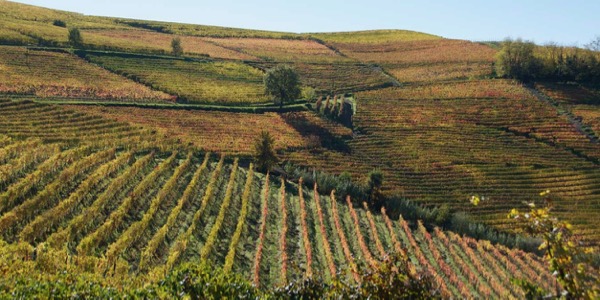
Roagna are ‘handcrafting fascinating, soulful Barbarescos and Barolos of mesmerising depth’ – Kerin O’Keefe
**This offer is subject to allocation. You will only be billed when your allocation has been confirmed**
About the Wines
Solea 2018
The grapes for Solea are sourced from the Pira Vineyard located within the historic village of Castiglione Falletto.
Our vineyard sits on the side of Serralunga d’Alba and Perno and is Southeast facing. Pira contains specific characteristics due to the slow disintegration of the rocks of Castiglione. Our family purchased this vineyard in 1989.
Solea is sourced from the bottom section of the Pira vineyard using Chardonnay vines that are approximately thirty years old. Additionally there is a percentage of Nebbiolo added to this white blend.
Harvest takes place in September, usually in one day, when the fruit has reached perfect physiological maturity. The fruit is placed gently into small containers.
Before being made into wine we manually select each berry in order to have perfect fruit.
Fermentation last about ten days and takes place exclusively in large wood casks thanks to a pied de cute created from our indigenous yeasts.
The wine is then aged in a neautral oak barrel for about two years.
The production of bottles is limited to a little more than one thousand bottles per year.
We number each bottle on the label.
Timorasso Derthona Montemarzino 2018
APPELATION: Piemonte IGT
WINE TYPE: White
VARIETALS: Timorasso
ORGANIC: Practicing
VINEYARD: Sourced from a one hectare vineyard in the town of Montemarzino in the Colli Tortonesi area.
SOIL: Mainly limestone-clay and rocks with a high level of active limestone.
VITICULTURE: Practicing organic. Hand-harvested.
VINIFICATION: Fermented with a pied de cuvee of natural yeasts in large french oak casks.
AGING: Aged for two years in one large french oak cask.
NOTES: Derthona is the old name for Tortona, the area in Piedmont where Timorasso is traditionally grown. The Timorasso origins are hundreds years old, an ancient document recounts of Leonardo Da Vinci (1452-1519) who gave Timorasso for a wedding gift to Isabella D’Aragona.
Dolcetto d'Alba 2019
We make Dolcetto d’Alba using fruit from our Pajé and Carso vineyards.
Pajé is one of the historic vineyards of the village of Barbaresco and it located in the center of the area planted to vines. Pajé is particularly rich in calcareous marl soil with a high content of active limestone. The amphitheater of Pajé opens onto the Tanaro river valley which mitigates the cold winters and hot summers. Pajé is a small strip of land facing South West.
The name Carso is derived the Piemontese dialect (Cors and it is one of the historic vineyards located within the village of Barbaresco. Carso sits next to the fortresses of Barbaresco, facing East, with limestone clay soil and a significant presence of sand.
The vines for this wine have a minimum of 45 years of age.
The roots are sourced by used the massage wood system by using only clippings that we have pruned from the Paje and Carso vineyards respectively.
Harvest takes place in September when the fruit has reached perfect physiological maturity. The fruit is placed gently into small containers.
Before being made into wine we manually select each berry in order to have perfect fruit.
Fermentation takes place exclusively in large wood casks thanks to a pied de cuve created from our indigenous yeasts. This lasts for ten days and then we use the ancient technique of maceration by splinting the submerged cap dirovere neutro per circa un anno. process which lasts for at least three months, (90 – 100 days). The wine is then aged in a neutral oak barrel for approximately one year.
I must put my big boy pants on soon, and get to the huge pile of Barberas I have waiting for me to taste. Meanwhile, another lovely Dolcetto. 2019 was an excellent vintage for Dolcetto, I think.
As ever, a serious Dolcetto of firm structure and depth, so much so, that you can almost smell the tannin. Dark cherry, raspberry, plenty of spice and perfume, leather and a little smokiness. It’s tight and ‘mineral’, cool acidity, slightly rustic, but in a good way, chewy Turkish coffee tannin, and a fresh berry finish of fine length with grit of tannin to close.
Barbera d'Alba 2015
Our Barbera d’Alba wine is produced using fruit from our Pira vineyard.
Pira is a historic vineyard located in the village of Castiglione Falletto and originally owned by the noble family who had a private road that connected the vineyard and the castle hundreds of years ago. Our vineyard sits on the side of Serralunga d’Alba and Perno and is Southeast facing. Pira contains specific characteristics due to the slow disintegration of the rocks of Castiglione. Our family purchased this vineyard in 1989. At the top of our vineyard, above our old vine Nebbiolo, sits our old vine Barbera with a total area of 0.34 Hectare (0.84 Acres).
Harvest takes place at the beginning of October when the fruit has reached perfect physiological maturity. The fruit is placed gently into small containers. Before being made into wine we manually select each berry in order to have perfect fruit.
Fermentation takes place exclusively in large wood casks thanks to a pied de cuve created from our indigenous yeasts. This lasts for ten days and then we use the ancient technique of maceration by splinting the submerged cap process which lasts for at least two and a half months, (70 – 80 days). The wine is then aged in a neutral oak barrel for approximately five years.
The production of bottles is limited to little more than a couple of thousand per vintage.
Langhe Rosso 2015
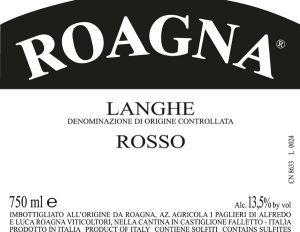 We make Langhe Rosso from our young vines planted in the Pajè and Pira vineyards.
We make Langhe Rosso from our young vines planted in the Pajè and Pira vineyards.
Pajè is one of the historic vineyards of the village of Barbaresco and it located in the center of the area planted to vines. Pajé is particularly rich in calcareous marl soil with a high content of active limestone. The amphitheater of Pajé opens onto the Tanaro river valley which mitigates the cold winters and hot summers. Pajé is a small strip of land facing South West.
Pira is a historic vineyard located in the village of Castiglione Falletto and originally owned by the noble family who had a private road that connected the vineyard and the castle hundreds of years ago. Our vineyard sits on the side of Serralunga d’Alba and Perno and is Southeast facing. Pira contains specific characteristics due to the slow disintegration of the rocks of Castiglione. Our family purchased this vineyard in 1989.
The vines for this wine have approximately 20 – 25 years of age. The roots are sourced by used the massage wood system by using only clippings that we have pruned from the Paje and Pira vineyards respectively.
Harvest takes place during the month of October when the fruit has reached perfect physiological maturity. The fruit is placed gently into small containers. Before being made into wine we manually select each berry in order to have perfect fruit.
Fermentation takes place exclusively in large wood casks thanks to a pied de cuve created from our indigenous yeasts. This lasts for ten days and then we use the ancient technique of maceration by splinting the submerged cap process which lasts for at least two months, (60 days). The wine is then aged in a neutral oak barrel for approximately five years.
Younger vines (25+ years old, mind you), from the Pajé (Barbaresco) and Pira (Barolo) crus. If you can’t afford the Pira or the Pajé, not least the VV versions, this gives you a fair approximation at a much lower entry price. Also, 2015 is a lovely vintage.
Strawberry and raspberry, plenty of spice and perfume, some liquorice root and a camphor-like lift. Medium to full-bodied, fresh with a fine graphite feel to tannin and cool acidity, lovely energy and shape through the mouth – a wine that knows what it’s doing – then strawberry and cherry carry on a long finish laden with brick dust tannin. Terrific in 2015.
Barbaresco Albesani 2015
The 2015 Barbaresco Albesani is gracious, floral and lifted, which is not common in Albesani, where the wines tend to be more powerful. Bright acids and lively tannins give the 2015 its shape and energy. This translucent, inviting Barbaresco has so much to offer.
Barbaresco Faset 2015
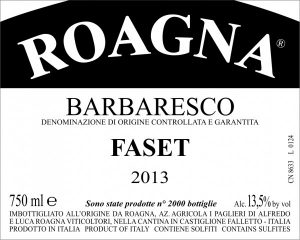 In 2013 Roagna began a collaboration with the owner of the historic vineyard Faset in Barbaresco. 2013 was our first year of production.
In 2013 Roagna began a collaboration with the owner of the historic vineyard Faset in Barbaresco. 2013 was our first year of production.
Faset is a historic cru, close to Asili and the Rocche di Barbaresco which produces incredibly elegant wines.
This little parcel is South West exposed. Receives the same vineyard work, 60 days of maceration and 5 years in a big tina. A couple of thousand bottles made.
The 2015 Barbaresco Faset is powerful and wild in the glass. Next to some of the other wines in the range, the Faset is a bit unruly, but that ultimately adds to its character. Spice, leather, tobacco and dried herbs all develop over time. Readers should plan on cellaring the 2015 for at least a few years, as it needs time to come together.
Barbaresco Gallina 2015
The 2015 Barbaresco Gallina is a very pretty, classic Barbaresco from this Neive site. Rose petal, spice, cedar, sweet pipe tobacco, mint, anise and orange zest all grace this delicious, wonderfully inviting Barbaresco. Soft, silky and impeccable in its balance, the 2015 can be enjoyed with minimal cellaring.
Neive. Chicken.
Fragrant, supple, seductive style. Cherry and ripe strawberry, spiced cocoa, tobacco and mint. It’s fleshy and ripe with a flood of smooth tannin, cherry and spice with a twist of orange peel. Finish is long, round and satisfying, with chamois-like tannin pushing it out. A lot happening in the glass here, even as a youngster.
Barbaresco Pajè 2015
 The name Pajé is derived from the local dialect, which historically were used to name each parcel of land. Pajé is one of the historic vineyards of the village of Barbaresco and it located in the center of the area planted to vines.
The name Pajé is derived from the local dialect, which historically were used to name each parcel of land. Pajé is one of the historic vineyards of the village of Barbaresco and it located in the center of the area planted to vines.
Pajé is the historic vineyard on our property where there is a larger concentration of limestone. The soil was formed during the Tertiary (Cenozoic) period approximately seventy-million years ago as a result of marine sedimentation founder under the ocean which covered all of our land. The hill of Pajé is the perfect example of a hill in Langhe: a wonderful piece of land protected from the wind by the surrounding hills and facing the Tanaro river valley which mitigates the cold winters and hot summers.
The vineyard is an amphitheater and has an average altitude of two-hundred and thirty (230 meters) above sea level which is traditionally perfect here for growing grapes. The Nebbiolo vines are planted on 1.83 hectares (4.52 acres) and near the bottom of the amphitheater we have Dolcetto vines with an average age of over 50 years.
The vines for this wine are between 25 and 50 years of age and today the average ages of the vines is over forty years old. The roots are sourced by used the massage wood system by using only clippings that we have pruned from the Paje vineyard.
The harvest takes place in October by hand usually in the morning once the fruit has reached perfect ripeness. Before being made into wine we manually select each berry in order to have perfect fruit.
Fermentation takes place exclusively in large wood casks thanks to a pied de cuve created from our indigenous yeasts. This lasts for ten days and then we use the ancient technique of maceration by splinting the submerged cap process which lasts for at least two months, (60 – 70 days). The wine is then aged in a neutral oak barrel for approximately 5 years.
The 2015 Barbaresco Pajè is the most nuanced and complete of the four wines in this lower tier of vineyard designates. Deceptively light in body, the 2015 possesses striking complexity and dimensions. Breadth and power are implied more than overtly stated. Clean, minerally notes punctuate the finish. The Pajè packs a serious punch. It will be even better in another few years' time. This is just classic Roagna and the wine in this range that offers the best value. I loved it.
Balsamic notes of camphor meld with ripe dark-skinned cherry, leather and dark spice. Delicious and loaded with personality, the enveloping palate doles out juicy black cherry, raspberry jam and star anise alongside earthy hints of truffle and game. Tightly knit, fine-grained tannins provide the framework. Drink after 2025.
Interesting, the use of the letter ‘J’ in Piedmont. Quite rare in Italian otherwise. Juventus F.C. is another example.
Firm, precise and very ‘mineral’ expression of Barbaresco. Sweet cherry, mint, exotic spice, clean damp earth. It’s clear and powerful, but not heavy, tightly-knit tannin, a little orange flavour with cinnamon and aniseed adding perfume on a long and focussed finish. A very impressive release.
Barolo Pira 2015
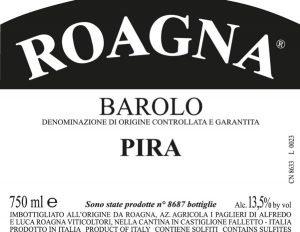 Pira is a historic vineyard located in the village of Castiglione Falletto and originally owned by the noble family who had a private road that connected the vineyard and the castle hundreds of years ago.
Pira is a historic vineyard located in the village of Castiglione Falletto and originally owned by the noble family who had a private road that connected the vineyard and the castle hundreds of years ago.
Our vineyard sits on the side of Serralunga d’Alba and Perno and is Southeast facing. Pira contains specific characteristics due to the slow disintegration of the rocks of Castiglione. Our family purchased this vineyard in 1989.
Castiglione Falletto is one of the eleven villages comprising the classified zone of Barolo. The village is geographically located in the center or the region and thus comprises a unique set of soil characteristics. The soil contains sedimentary marine elements dating back to the Tertiary (Cenozoic) period. Specifically, the geological formation of our soil is the oldest of the Barolo zone and similar soil can be found in the three villages of Castiglione Falletto, Serralunga d’Alba and Monforte d’Alba. The Pira vineyard, which was created from the weathering of rocks, has many layers of alternating white limestone, marl gray, blue marl, sands, with a high content of minerals including iron.
This is the largest vineyard owned by our family. We have 7 hectares (17.3 acres) planted to vines as well as 4 hectares (9.88 acres) of forest. The land is protected at the top by the Rocche of Castiglione and downstream from the forest with a stream flowing from Bussia of Monforte d’Alba. The habitat is ideal for our concept of respecting the land and the life of the soil.
The grape varieties we have at Pira include mostly Nebbiolo with a small quantity of Barbarea and Chardonnay. There are 6 unique micro parcels depending on the composition of the terrain which can range from limestone marl Roca to blue stone. The roots of each vine are only regenerated by pruning in the Pira vineyard and then replanting the same clippings from the old vines of Pira using the massale woods.
The oldest plant dates back to 1937. Currently, we have planted an experimental parcel of vines using the seeds from all of our historic vineyards in order to attempt to create a lineage linked directly from our vines while also increasing biodiversity.
The vines for this wine are between 25 and 50 years of age. The roots are sourced by used the massage wood system by using only clippings that we have pruned from the Pira vineyard.
The harvest takes place normally during the middle of October by hand into small containers usually in the morning once the fruit has reached perfect physiological ripeness. Before being made into wine we manually select each berry in order to have perfect fruit.
Fermentation takes place exclusively in large wood casks thanks to a pied de cuve created from our indigenous yeasts. This lasts for ten days and then we use the ancient technique of maceration by splinting the submerged cap process which lasts for at least two months, (60 – 75 days). The wine is then aged in a neutral oak barrel for approximately 5 years.
The 2015 Barolo Pira is lifted and gracious in feel. In this vintage, the Pira is notably perfumed and restrained. Rose petal, mint, crushed flowers, dried cherry, star anise and cinnamon are some of the many notes that grace this delicate, lilting Barolo from Luca Roagna. The tannins are persistent and fine, lending a slightly nervous feel.
Leather, forest floor, rose and camphor aromas take shape on this fragrant red along with a whisper of tobacco. Polished, linear and savory, the elegantly structured palate features juicy cranberry, orange zest, licorice and a hint of baking spice. Taut, refined tannins provide support while fresh acidity keeps it nicely balanced. Drink 2022–2030.
I wasn’t a huge fan of the 2014 Pira, but this is much much better. As you’d expect. Anyway, Pira sits below Rocche di Castiglione, and as far as I know, Roagna are the only producer to bottle a wine from this MGA.
Fine perfume of dried flowers, maybe even chamomile, cherries dusted in cocoa, mint, tobacco and sweet spices. Almost juicy red fruits, blood orange and cinnamon, cool acidity, fine chalky dust tannin, pulls a bit more savoury and earthy on a long and fresh finish sprinkled with amaro herbs and almond. A charmer.
Barolo del Comune di Barolo 2015
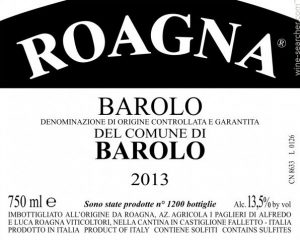
The 2015 Barolo del Comune di Barolo is a gorgeous entry-level wine in this range. Succulent and forward, the 2015 offers quite a bit of immediacy and sheer appeal. Sweet red cherry fruit, spice, leather, mint, cedar and pipe tobacco are nicely pushed forward, but there is plenty of tannic spine underneath. This is an especially open-knit wine from Luca Roagna, not that I think most readers will have an issue with that, especially those of us who remember the bruisers of the past. The Barolo del Comune di Barolo is one of the wines in this range savvy readers will want to focus on for its quality, value and sheer deliciousness. Sadly, there are fewer than 100 cases to go around.
Violet, menthol, new leather and wild berry aromas waft out of the glass. The elegant palate offers juicy Marasca cherry, baking spice and a hint of rusty nail alongside taut, polished tannins. Drink 2022–2027.
Barbaresco Pajè Vecchie Viti 2015

The 2015 Barbaresco Pajè Vecchie Viti is beautifully perfumed and lifted from the very first taste. There is an element of translucence to the 2015 that is utterly beguiling. Rose petal, mint, sweet red cherry, spice and new leather all grace this understated, alluring Barbaresco. All the elements fall into place effortlessly.
Aromas of camphor, new leather, sunbaked soil and a whiff of violet shape the nose on this enthralling wine. Full bodied and boasting a concentrated depth of delicious flavors, the structured linear palate delivers mature Morello cherry, blood orange, star anise and tobacco set against a backbone of firm but refined tannins. Fresh acidity provides balance. Drink 2027–2040.
Barbaresco Asili Vecchie Viti 2015
The name Asili (Asei) is derived from the local dialect, which historically were used to name each parcel of land. Asili is one of the historic vineyards of the village of Barbaresco and it located in the Southern portion of the area planted to vines.
Asili is particularly rich in limestone and marl mixed with strands of reddish yellow sands. Our parcel covers an area of 0.22 Hectare (0.54 Acre). Giovanni Roagna purchased the land in 1961 and it is located exactly in the middle of the hill.
The vines for this wine have a minimum age of 50 years, thus considered old vines, and are regenerated using the massale wood system by pruning the vines within the same vineyard.
The harvest takes place in October by hand usually in the morning once the fruit has reached perfect ripeness. Before being made into wine we manually select each berry in order to have perfect fruit.
Fermentation takes place exclusively in large wood casks thanks to a pied de cuve created from our indigenous yeasts. This lasts for ten days and then we use the ancient technique of maceration by splinting the submerged cap process which lasts for at least two and a half months, (70- 90 days).
The wine is then aged in a neutral oak barrel for approximately 5 years.
The 2015 Barbaresco Asili Vecchie Viti lifts from the glass with striking aromatics. Then again, that's Asili. Sweet red berry fruit, mint, blood orange, cinnamon and star anise form a gorgeous latticework of aromas and flavors. The 2015 is gracious, light on its feet and full of Asili seduction, but with that extra kick if tannic bite that is such a Roagna signature. It will be even better once those tannins soften a bit further.
From one of the greatest vineyard sites in Barbaresco, this captivating wine boasts enticing perfumes of fragrant purple flower, pressed rose, new leather, forest floor and dark spice. The palate is both elegant and earthy, doling out juicy Marasca cherry, crushed raspberry, truffle and star anise before finishing on the barest hint of game. Taut, refined tannins and bright acidity keep it focused and balanced. Drink 2025–2035.
Barbaresco Montefico Vecchie Viti 2015
The name Montefico is derived from the local dialect, which historically were used to name each parcel of land. Montefico is one of the historic vineyards of the village of Barbaresco and it located in the Eastern portion of the area planted to vines.
Montefico has calcareous marl soils with a good amount of limestone. Our parcel is in the shape of a triangle and is exactly in the middle of the hill in the middle part of the amphitheater facing the village of Neive. Our portion of the vineyard covers an area of 0.24 Hectare (0.59 Acre). The parcel was purchased by our family in 1929.
The vines for this wine have a minimum age of 50 years, thus considered old vines, and are regenerated using the massale wood system by pruning the vines within the same vineyard.
The harvest takes place in October, by hand usually in the morning once the fruit has reached perfect ripeness. Before being made into wine we manually select each berry in order to have perfect fruit.
Fermentation takes place exclusively in large wood casks thanks to a pied de cuve created from our indigenous yeasts. This lasts for ten days and then we use the ancient technique of maceration by splinting the submerged cap process which lasts for at least two and a half months, (70-90 days). The wine is then aged in a neutral oak barrel for approximately 5 years.
The 2015 Barbaresco Montefico Vecchie Viti is a great example of this site. Iron, smoke, crushed rocks, sage, mint and licorice bring out the wilder, savory side of this Barbaresco vineyard. Firm and muscular in the glass, with striking depth, the 2015 has so much to offer. It does need at least a few years in bottle to be at its best.
Showing more strength and intensity than you normally find in Barbaresco, this stunning red opens with heady scents of wild berry, new leather, underbrush and menthol. The compelling palate features mature black raspberry, juicy cherry and licorice before finishing on a note of tobacco. It's still youthfully nervous and austere so give it time to fully develop. Drink 2027–2040.
Barolo Pira Vecchie Viti 2015
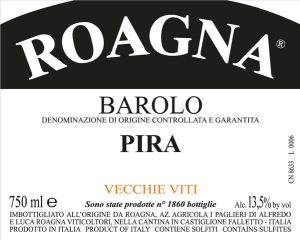
The 2015 Barolo Pira Vecchie Viti needs a bit of time in the glass for an initial whiff of reduction to blow off. As it often is, the Pira Vecchie Viti is an exotic wine built on an intriguing mix of aromatic presence and understated structure. In 2015, the two Pira Barolos are not as different as they usually are. While the Vecchie Viti has terrific persistence, it also is a bit fleeting for this wine.
Another drop-dead gorgeous wine from this dynamic estate, this elegantly structured wine opens with tantalizing aromas of camphor, fragrant purple flower, ripe berry, sunbaked earth and tobacco. Made with fruit from old vines, the youngest dating back to 1937, the compelling palate combines structure and grace, delivering pristine fruit sensations of strawberry compote and red cherry while licorice, baking spice and truffle add depth. Refined tannins and fresh acidity keep it balanced and vibrant. Drink 2023–2035.
Barbaresco Crichët Pajé 2012
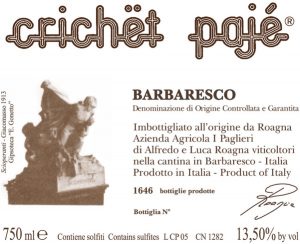
The name Crichet Pajé comes from the Piemontese dialect. When the Italian State was created, each parcel of land was given an official name.
The word Crichet is translated as “top of the small hill”. This is our ultimate location for the cultivation of Nebbiolo. The Nebbiolo grape performs best when it is well exposed as well as sheltered from the strongest winds from the tallest hills; Pajé term refers to the vineyard location.
Crichet Pajé is a micro parcel located within the same area, which is particularly rich in white calcareous soil and has our highest content of active limestone. The Paje vineyard is 0.5 Hectare (1.24 Acres) with a unique microclimate and soil which enjoys a view over the Tanaro river valley. The exposition mitigates the cold winters and hot summers. The vineyard is located in the center of the Pajé designated area with additional area facing Southwest.
The youngest vines used for this wine are more than 60 years-old with all vines regenerated by using clippings from other vines exclusively located within the same area.In fact, some of the vines have been propagated by using ungrafted vines. The older vines have reached a balance of optimum production even though some plants produce only a single cluster during some years.
This wine is born from the experience over many years by Giovanni Roagna. After purchasing the vineyard in 1953, Giovanni spent many years of experimentation in order to seletec this unique terroir. Over the years this wine was aged for as long as it needed in orer to reach maturity and the wine was saved for the family as well as used for important events.
In 1978, Alfredo Roagna decided to present Crichet Pajé to the marketplace for the first time.
The 2012 Barbaresco Crichët Pajè is tight and not especially expressive today. In this vintage, the Crichët Pajè is a bit more floral and lighter in structure than it can be. Imagine Burgundy with Nebbiolo acids and tannins. Among other things, that means the 2012 will drink well with minimal cellaring, in relative terms for this bottling. Despite its reticence, the 2012 is also restrained and so nuanced. I can't wait to see how it develops in bottle.
Camphor, truffle, wild berry and new leather are just some of the aromas you'll encounter on this riveting red. The enveloping, delicious palate shows both power and finesse, featuring dried cherry, pomegranate, star anise and tobacco framed in noble tannins. Surprisingly bright acidity for the warm vintage lends balance and even more intensity. Drink 2022–2032.
Roagna’s Manifesto
#01 Old Vines
We believe that in order to express our terroir it is essential to work with old vines which at our estate are often more than fifty years old: the individuality and beauty of a particular vineyard occurs when plants have extremely deep root systems.
The Langhe soils are of composed of a marine sedimentary origin which contain layers of calcareous clays alternating with bluish gray marl and sands. The authenticity of each unique expression comes from small differences in the subsoil. It is easy to understand how a fifty year-old grapevine with roots growing down into many different sedimentary layers can draw unique nutrients and trace elements specific that give that vine distinct characteristics.
Our vines are not fertilized or irrigated. The topsoil is covered with grass which challenges each vine to search deeper for nutrients.
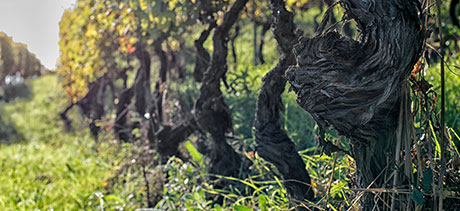
#02
Massale Selection. We believe that the beauty of a wine begins with a concert played by thousands of unique grapevines where each individual vine interprets their own personal subsoil.
Different rootstalk present in our vineyards have been created using the wood of older vines found in our vineyards which contain site specific geographical indications. This maintains a diverse population in order to ensure biodiversity and the expression of each individual plant. The beauty of our native variety grapevines in the Langa is derived from centuries of adaption to the our land. We consider this essential to keep the plants that have adapted to each single vineyard. The common practice in our vineyards does not mix or modify the rootstalk; instead we create new plants from our old vines using clippings which have already proven historically to be perfectly adapted to each single vineyard parcel..
In 2012 we began a trial using seeds harvested from the fruit of our oldest vines found in several different parcels in order to create the next generation of vines. This was a practice of monks centuries ago and it is still very important to create the next generation which will help to preserve, and potentially even increase, the biodiversity of our vineyard in the coming years.
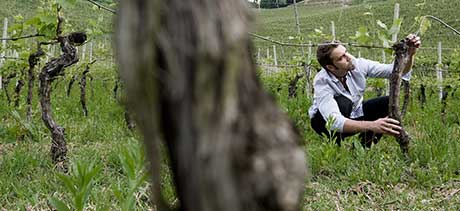
#03
Biodiversity, No herbicides, No Pesticides, No Fertilizers
We believe the perfect environment for the life of all plants and animals is found in the forest.
In our vineyards the grapevines live in symbiosis with herbs, microorganisms, and animals all present. Grapevines have been cultivated in this fashion for thousands of years.
In order to care for each plan we must first respect everything that surrounds it. We believe in allowing a completely natural cover crop without any mowing which allows for many varieties of plants to coexist.
When a farmer decides to mow he or she is selecting specific families of herbs to be allowed to grow, usually grass, which are more resistant and less competitive with the vine. We believe that during springtime the vineyard should become a garden filled with flowers and hundreds of different species of plants living in equilibrium with each other. We do not fertilize the ground because we do not want lazy plants with roots that sit only on the surface. We need hearty strains of plants which have root systems that grow several meters deep. In fact, grass is a wonderful help because it competes with the vine in the first meter of soil which then stimulates the roots of the vine to search deeper into the earth. We use copper and sulfur to treat fungal diseases just as our ancestors have done before us.
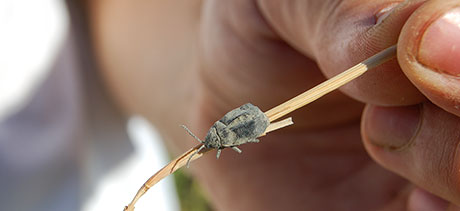
#04
Maturity at Harvest
Harvest takes place when the berry has reached perfect ripeness. We believe it is not helpful to evaluate the sugar content of the grapes as this could potential errors in judgment during very hot vintages when sugar content precedes maturation of the grape.
As children in our family, we are taught to taste the berries paying particular attention to the skin and seeds. The berries are at optimal ripeness and ready to harvest only when they have a crisp texture.
Old vines, massale selection and naturally fertilized vineyards gives us the opportunity to harvest grapes that combine perfect physiological maturity with moderate potential alcohol, close to zero malic acid and high tartaric acid.
Each year during the early to middle part of September we begin our harvest in our vineyards planted to Dolcetto. The first harvest is in Dolcetto in early-mid September. The Nebbiolo harvest is much longer and can last 3-4 weeks. Each vineyard parcel has a perfect moment of physiological maturity and can vary based on the age of the vines, as well as the directional exposure and altitude. During the harvest we gently lay each cluster of berries manually into boxes containing a maximum weight of 10kg (22 lbs.). This prevents the berries from breaking during their short trip for the vineyard to the winery where they are immediately de-stemmed and crushed.
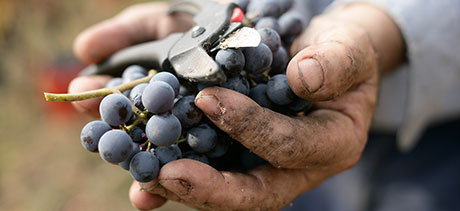
#05
Wild Yeast Fermentation
A few days before the grapes reach their physiological maturity for harvest we go out into the vineyard and collect a few baskets of grapes to create the pied de cuve for a pre-fermentation.
By using this ancient technique we reduce the many risks associated with natural fermentation such as certain non-Saccharomyces strains of yeast that may give unwanted aromas.
After collected the grapes are then pressed in a tub. Indigenous yeast fermentation begins after a few days and at this point we have full fermentation and we are ready to continue our harvest.
During harvest we bring the grapes to our cellar where they are immediately de-stemmed and crushed in order to maintain freshness and integrity of the fruit.
With gravity the must ends up in tine truncated oak.
The must from our earlier wild yeast fermentation is then added at this point or at most within a few days depending on the conditions of each vintage.
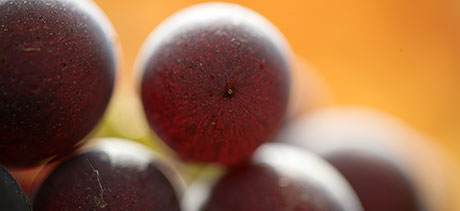
#06
Long aging in large oak casks
Our family follows a precise set of rules about aging our wine in large oak casks. Each wine should reach full maturity in wood and each single vineyard should express it’s own identity.
Our Pira and Asili vineyards are based on purity and elegance and thus typically require three to four years large oaks before they reach their full expression.
The Crichet Pajé, Pajé and Montefico vineyards need longer ageing due to their structure and complexity thus requiring between four and ten years of ageing in large oak casks.
Each wine requires it’s own time and we don’t follow a strict set of rules; however, we often look to our family history when considering the attributes of each unique wine.
We follow tradition by putting our wines in large cement caks to rest before bottling.
When a wine has reached full maturity, usually in the summer, we bottle the wine.
We meticulously select our wood which is often aged for up to ten years from a selection of suppliers who then hand build each large wooden cask. The staves are bent using steam instead of toasting which ensures that our wines mature slowly and maintain the purity of our wine without offering any wood flavors.
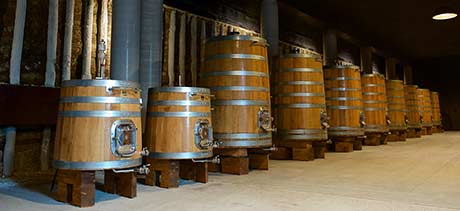
#07
Bottling using low sulfur and no filtration or fining
Our native varieties of grapevines yield grapes high in tannins which after a long maceration and aging in large wood casks create wines with structure and complexity.
These qualities protect the wine from oxidation during maturation thus allowing us to use minimal levels of sulfur. In some wines we are not required to add any sulfur because there is already enough natural sulfur in the wine.
We attempt to use the lowest levels of sulfur possible, while maintaining the integrity of our wines for long aging. We mostly use sulfur to protect our wines from mold and bacteria.
Dolcetto matures for about one year, our white wine for two years, and our Barbaresco and Barolo wines for at least five years. After such long aging times there is no need to filter or clarify our wines because the wines are perfectly clean.
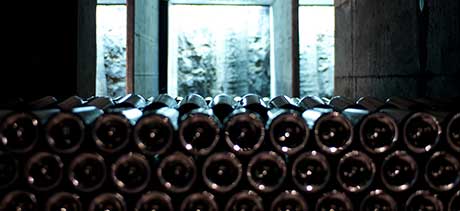
#08
Long maceration using a submerged cap
Over many centuries of experience we believe that the maceration of the grapes is a fundamentally important step as the cluster of grapes transforms into wine.
In the Langa our ancestors traditionally kept the skins of the berries in contact with the must for months.
Giovanni Roagna separated Nebbiolo juice from the skins just before or just after December 25th and sometimes into the month of January of the year after harvest as he had been taught by his ancestors.
The ancient technique of splinting or submerging the cap is practiced by fully closing the top opening of the wood cask and then placing the planks of oak in a parallel pattern.
The skins, or cap, is then fully submerged in the wine.. This process allows for an elegant transfer of the wine as it retains some of the noble elements found in the skins. We macerate our wine for an average of sixty to one-hundred days.
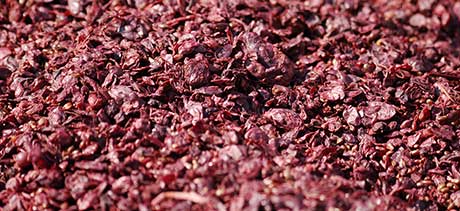
#09
Family tradition
Quite simply, our family has always worked in the vineyards.
Today Alfredo and Luca Roagna, father and son, work everyday to care for each vine. Each vine is treated as an individual who year after year evolves to express the unique characteristics of our terroir.
We work tirelessly taking care of every single stage of the process from the vineyard to the bottle.
In the cellar after all the work we have done with selection and crushing, we also personally bottle and label the wine and prepare each box for shipping to our clients around the world. Each and every bottle of wine is handled at least six times before leaving our winery by Alfredo or Luca.
We do not have have any other winemakers or agricultural specialists who work with us as we try only to interpret each vineyard with our generations of family experience.
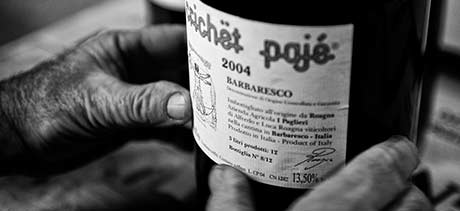
#10
Purity from the terroir without any oak flavor
Our ultimate goal is to express the beauty of each singular piece of land in the wines without interfering in any way with smells or flavors associated with toasted wood.
We think that the uniqueness originated from our vineyards should dominate over winemaking techniques. If we balance all of the factors unique to our vineyards and grapevines, we believe our wines will share this identity and emotion.
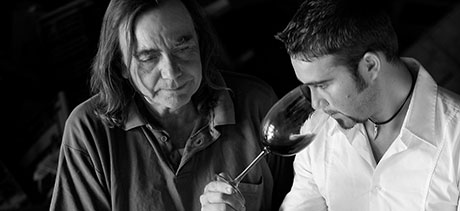
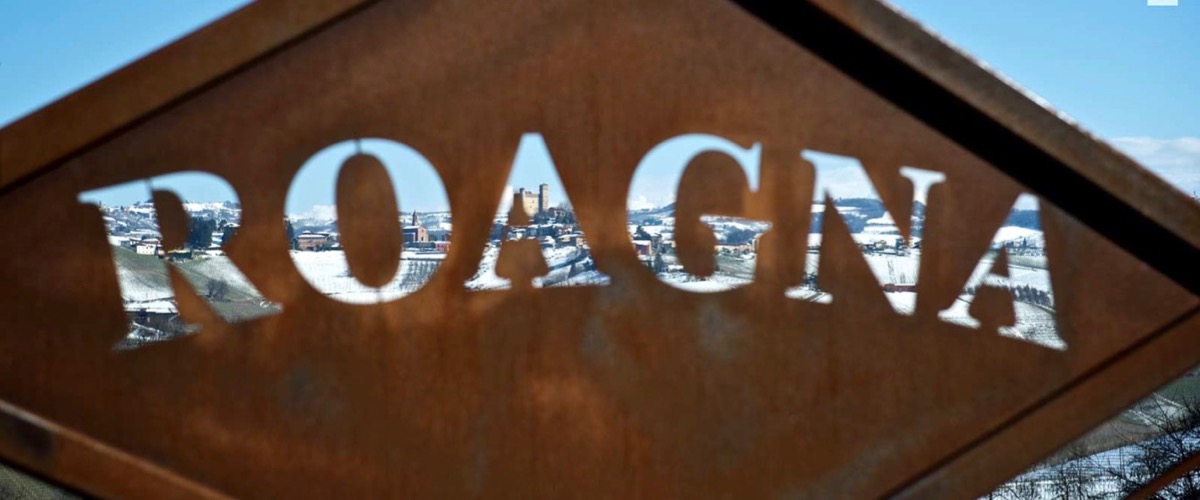













You must be logged in to post a comment.